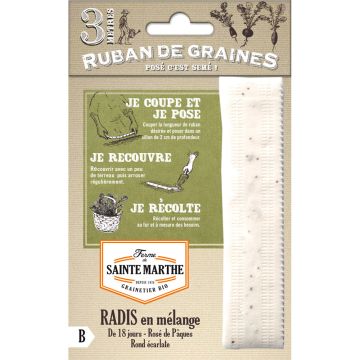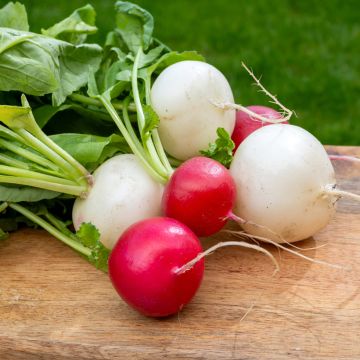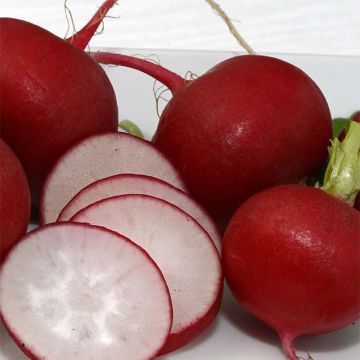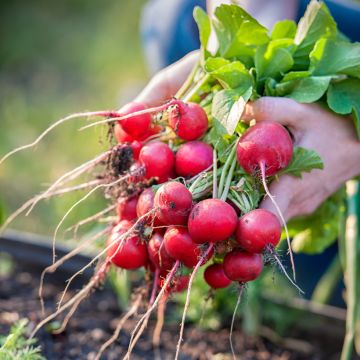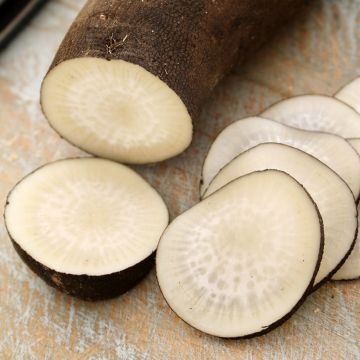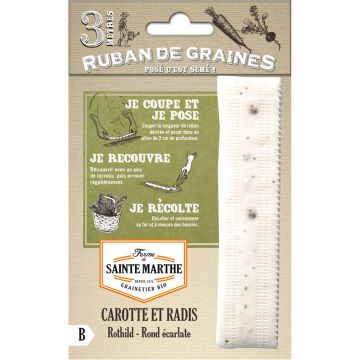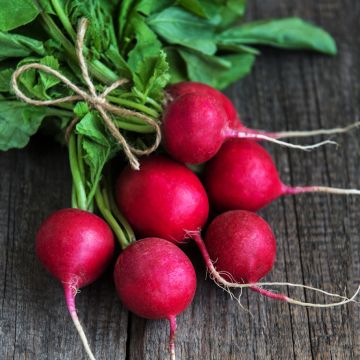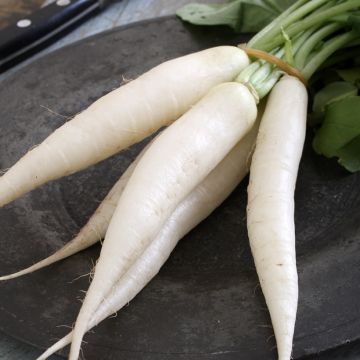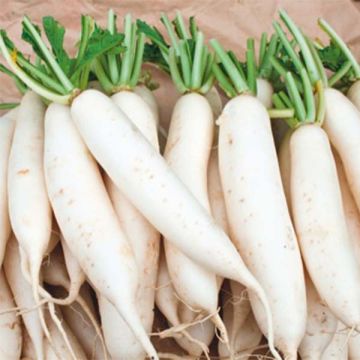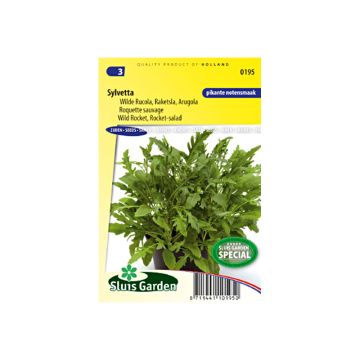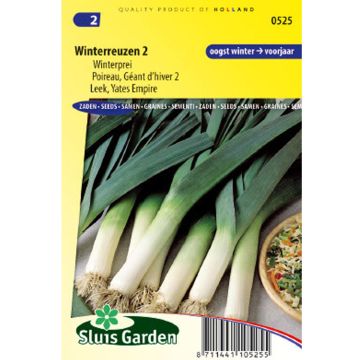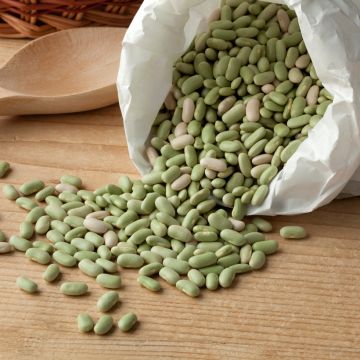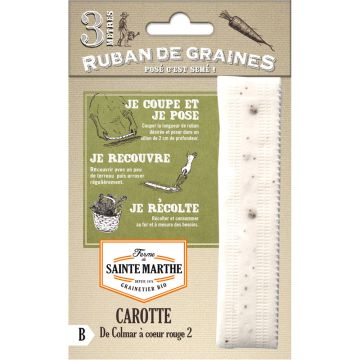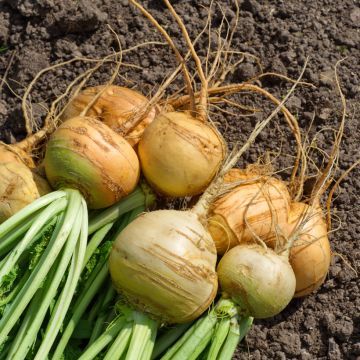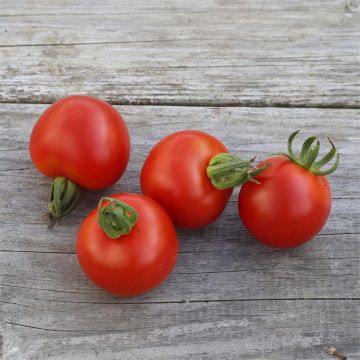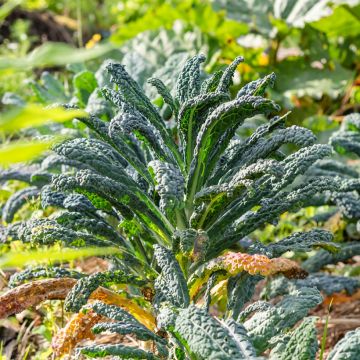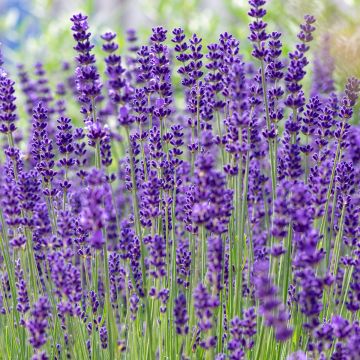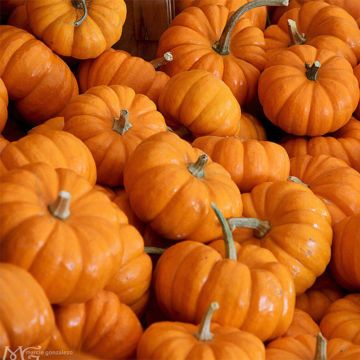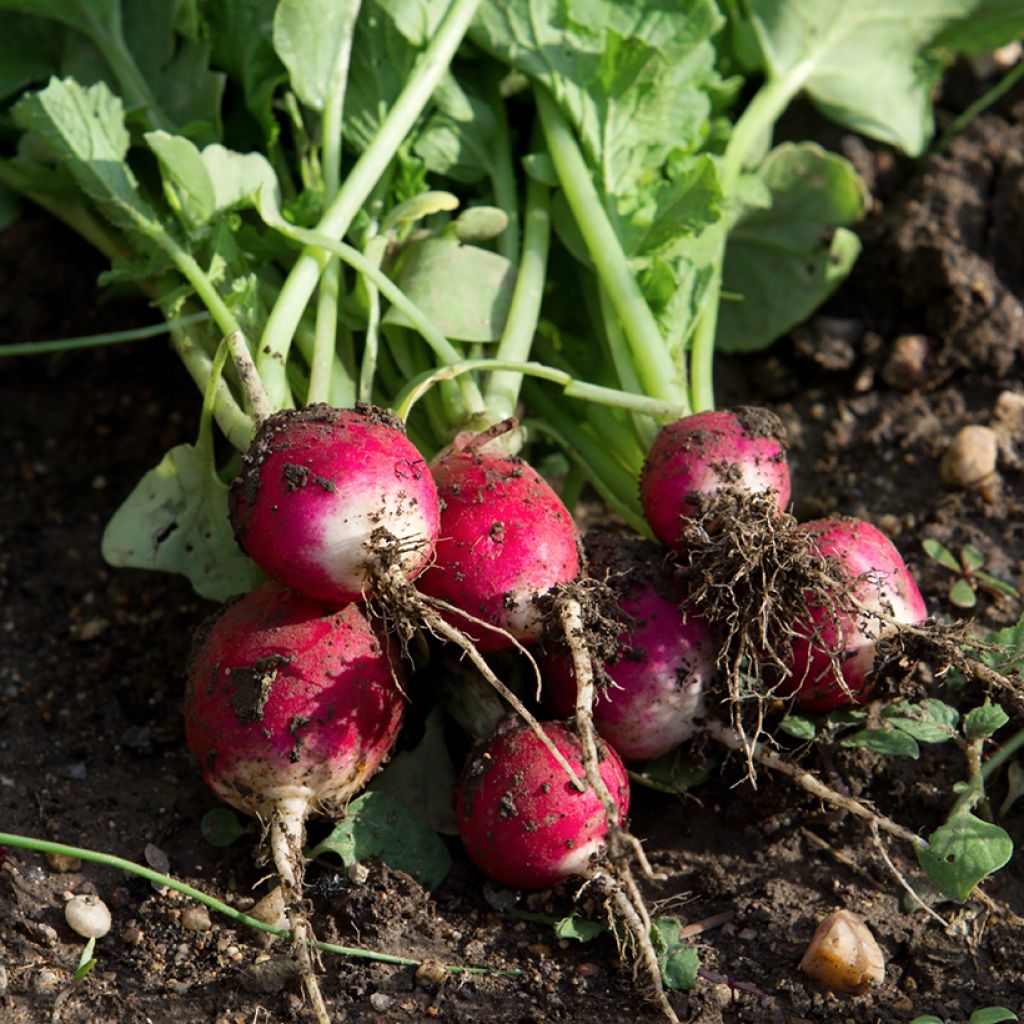

Radish National 2 organic seeds
Radish National 2 organic seeds
Raphanus sativus National 2
This item cannot be shipped to the selected country
Delivery charge from €5.90
More information
Schedule delivery date,
and select date in basket
This plant carries a 6 months recovery warranty
More information
We guarantee the quality of our plants for a full growing cycle, and will replace at our expense any plant that fails to recover under normal climatic and planting conditions.
From €5.90 for pickup delivery and €6.90 for home delivery
Express home delivery from €8.90.
Description
The National 2 Radish, offered here in the form of AB certified seeds, is an old French variety cultivated for over 150 years. This radish is distinguished by its round root of bright carmine-pink with a white tip, and by its white, tender and crunchy flesh, with a sweet flavour. It is early, harvested approximately 25 to 28 days after sowing, without becoming hollow or pungent, if well maintained. The harvest, which extends from April to November, should be done as soon as the roots are sufficiently developed and before they grow too large. This easy-to-grow variety is ideal for regular harvests throughout the season.
The radish is a robust vegetable plant, grown as an annual or biennial, belonging to the Brassicaceae family. Its root is mainly consumed, often raw, but its fresh leaves can also be used, especially to enrich soups. This plant offers a beautiful diversity of colours: red, pink, white or grey. Two main categories of radishes are distinguished: those known as "year-round radishes", with short and small roots, and larger radishes with long roots.
Year-round and summer radishes are harvested approximately 4 to 6 weeks after sowing. The roots should be picked as soon as they reach a sufficient size, but before they grow too large, to prevent them from becoming hollow or pungent. These radishes should be consumed quickly after harvest.
To maximise your space and simplify your crops, sow radishes and carrots in the same row. Radishes germinate quickly and naturally mark the rows, allowing carrot seeds, which are slower, to space out better. Once the radishes are harvested, the carrots will have more space to develop. To protect your radishes from flea beetles, these small insects that puncture the leaves, plant mint nearby: it acts as a natural repellent. Finally, to enjoy crunchy radishes throughout the season, make staggered sowings every 2 to 3 weeks in the garden or in a planter.
Report an error about the product description
Harvest
Plant habit
Foliage
Botanical data
Raphanus
sativus
National 2
Brassicaceae
Cultivar or hybrid
Annual
Other Radish seeds
Planting and care
Sowing
Sowing of National 2 radish is easy. The seeds are sown thinly, directly in place, in loosened soil, in rows or broadcast. Barely cover round radish seeds with potting soil or fine soil. Lightly press down with the back of the rake and water with a fine spray. Keep sufficiently moist until germination.
Radishes can be sown all year round, with a preference for late winter to early summer, avoiding periods of intense heat, then in late summer-early autumn, when the soil is still warm, before the first frosts.
Radishes like clear and sunny locations, and appreciate light shading in the heart of summer. Watering should be light but regular.
Sowing of monthly radishes and summer radishes
From May, you can sow as you wish until the end of summer, even early autumn if the climate allows, in open ground, in rows spaced 10 to 20 cm apart.
Maintenance
Once the sowing has germinated, thinning is necessary. This consists of removing the weakest plants to keep only the strongest ones every 4/5 cm, for year round radishes, and 10 to 15 cm for larger radishes.
Keep the soil relatively moist through regular watering. Hoeing, weeding, and mulching combined with watering will help limit the production of strong radishes and the preserved moisture will prevent flea beetle invasions, which proliferate in hot and dry weather.
Seedlings
Care
Intended location
This item has not been reviewed yet - be the first to leave a review about it.
Vegetable seeds
Haven't found what you were looking for?
Hardiness is the lowest winter temperature a plant can endure without suffering serious damage or even dying. However, hardiness is affected by location (a sheltered area, such as a patio), protection (winter cover) and soil type (hardiness is improved by well-drained soil).

Photo Sharing Terms & Conditions
In order to encourage gardeners to interact and share their experiences, Promesse de fleurs offers various media enabling content to be uploaded onto its Site - in particular via the ‘Photo sharing’ module.
The User agrees to refrain from:
- Posting any content that is illegal, prejudicial, insulting, racist, inciteful to hatred, revisionist, contrary to public decency, that infringes on privacy or on the privacy rights of third parties, in particular the publicity rights of persons and goods, intellectual property rights, or the right to privacy.
- Submitting content on behalf of a third party;
- Impersonate the identity of a third party and/or publish any personal information about a third party;
In general, the User undertakes to refrain from any unethical behaviour.
All Content (in particular text, comments, files, images, photos, videos, creative works, etc.), which may be subject to property or intellectual property rights, image or other private rights, shall remain the property of the User, subject to the limited rights granted by the terms of the licence granted by Promesse de fleurs as stated below. Users are at liberty to publish or not to publish such Content on the Site, notably via the ‘Photo Sharing’ facility, and accept that this Content shall be made public and freely accessible, notably on the Internet.
Users further acknowledge, undertake to have ,and guarantee that they hold all necessary rights and permissions to publish such material on the Site, in particular with regard to the legislation in force pertaining to any privacy, property, intellectual property, image, or contractual rights, or rights of any other nature. By publishing such Content on the Site, Users acknowledge accepting full liability as publishers of the Content within the meaning of the law, and grant Promesse de fleurs, free of charge, an inclusive, worldwide licence for the said Content for the entire duration of its publication, including all reproduction, representation, up/downloading, displaying, performing, transmission, and storage rights.
Users also grant permission for their name to be linked to the Content and accept that this link may not always be made available.
By engaging in posting material, Users consent to their Content becoming automatically accessible on the Internet, in particular on other sites and/or blogs and/or web pages of the Promesse de fleurs site, including in particular social pages and the Promesse de fleurs catalogue.
Users may secure the removal of entrusted content free of charge by issuing a simple request via our contact form.
The flowering period indicated on our website applies to countries and regions located in USDA zone 8 (France, the United Kingdom, Ireland, the Netherlands, etc.)
It will vary according to where you live:
- In zones 9 to 10 (Italy, Spain, Greece, etc.), flowering will occur about 2 to 4 weeks earlier.
- In zones 6 to 7 (Germany, Poland, Slovenia, and lower mountainous regions), flowering will be delayed by 2 to 3 weeks.
- In zone 5 (Central Europe, Scandinavia), blooming will be delayed by 3 to 5 weeks.
In temperate climates, pruning of spring-flowering shrubs (forsythia, spireas, etc.) should be done just after flowering.
Pruning of summer-flowering shrubs (Indian Lilac, Perovskia, etc.) can be done in winter or spring.
In cold regions as well as with frost-sensitive plants, avoid pruning too early when severe frosts may still occur.
The planting period indicated on our website applies to countries and regions located in USDA zone 8 (France, United Kingdom, Ireland, Netherlands).
It will vary according to where you live:
- In Mediterranean zones (Marseille, Madrid, Milan, etc.), autumn and winter are the best planting periods.
- In continental zones (Strasbourg, Munich, Vienna, etc.), delay planting by 2 to 3 weeks in spring and bring it forward by 2 to 4 weeks in autumn.
- In mountainous regions (the Alps, Pyrenees, Carpathians, etc.), it is best to plant in late spring (May-June) or late summer (August-September).
The harvesting period indicated on our website applies to countries and regions in USDA zone 8 (France, England, Ireland, the Netherlands).
In colder areas (Scandinavia, Poland, Austria...) fruit and vegetable harvests are likely to be delayed by 3-4 weeks.
In warmer areas (Italy, Spain, Greece, etc.), harvesting will probably take place earlier, depending on weather conditions.
The sowing periods indicated on our website apply to countries and regions within USDA Zone 8 (France, UK, Ireland, Netherlands).
In colder areas (Scandinavia, Poland, Austria...), delay any outdoor sowing by 3-4 weeks, or sow under glass.
In warmer climes (Italy, Spain, Greece, etc.), bring outdoor sowing forward by a few weeks.

































